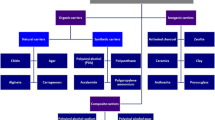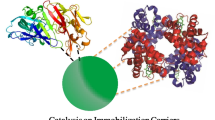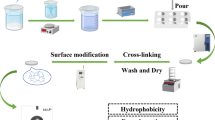Abstract
Sol gel technique, using tetrametoxysilane (TMOS) as precursor, was evaluated as a method for immobilization of a xylanase-producing Aspergillus niger sp strain. Although alcohol released by the hydrolysis–condensation reaction of silicon alkoxides during sol gel formation usually has a potential denaturing activity for the entrapped biological material, Aspergillus niger cells were resistant to this condition, maintaining part of its microbial activity and xylanase production ability after the immobilization process. Optical microscopy showed a significant mycelia growth in the inner part of the support after incubation in liquid cultures; meanwhile, in shake flasks cultures, immobilized cells maintained 56% of glucose uptake and retained 24% of xylanase activity, compared to free cells after 168 h of incubation at 37 °C. Results suggested that even though this fungus was able to overcome solvent toxicity caused by the sol gel immobilization technique, diffusional limitations were the reason for low glucose consumption and the drop in the production of the enzymatic activity observed. In our knowledge, this study is the first in which the immobilization of an A. niger strain in sol gel material is reported, and from this work further study is underway to improve the characteristics of the gel material used for immobilization, as well as to increase the xylanase and other polysaccharase production by sol gel entrapped fungus.





Similar content being viewed by others
References
Bhat MK (2000) Cellulases and related enzymes in biotechnology. Biotechnol Adv 18:55–383
Hoondal GS, Tiwari RP, Tewari R, Dahiya N, Beg QK (2002) Microbial alkaline pectinases and their industrial applications: a review. Appl Microbiol Biotechnol 59:409–418
Ali N, Ikramullah, Lutfullah G, Hameed A, Ahmed S (2008) Decolorization of Acid red 151 by Aspergillus niger SA1 under different physicochemical conditions. World J Microbiol Biotechnol 24:1099–1105
Yi-Rui W, Teng-Teng H, Jing-Sheng L, Maskaoui K, Tong-Wang H, Zhong H (2009) Removal of Benzo[a]pyrene by a fungus Aspergillus sp. AP14. World J Microbiol Biotechnol 25:1395–1401
Polizeli MLTM, Rizzatti ACS, Monti R, Terenzi HF, Jorge JA, Amorim DS (2005) Xylanases from fungi: properties and industrial applications. Appl Microbiol Biotechnol 67:577–591
Subramaniyan S, Prema P (2002) Biotechnology of microbial xylanases: enzymology, molecular biology, and application. Crit Rev Biotechnol 22(1):33–64
Arroyo M (1998) Immobilized enzymes: theory, methods of study and applications. Ars Pharm 39:23–39
Wang L, Ridgway D, Gu T, Moo-Young M (2005) Bioprocessing strategies to improve heterologous protein production in filamentous fungal fermentations. Biotechnol Adv 23:115–129
Asgher M, Asad MJ, Bhatti HN, Legge RL (2007) Hyperactivation and thermostabilization of Phanerochaete chrysosporium lignin peroxidase by immobilization in xerogels. World J Microbiol Biotechnol 23:231–525
Inama L, Dire S, Carturan G, Cavazza A (1993) Entrapment of viable microorganisms by SiO2 sol gel layers on glass surfaces: Trapping, catalytic performance and immobilization durability of Saccharomyces cerevisiae. J Biotechnol 30:197–210
Shati MR, Ronen D, Mandelbaum RT (1996) Atrazine degradation by Pseudomonas strain entrapped in sol gel glass. J Sol gel Sci Technol 7:77–79
Soltmann U, Böttcher H (2008) Utilization of sol–gel ceramics for the immobilization of living microorganisms. J Sol gel Sci Technol 48:66–72
Fennouh S, Guyon S, Livage, Roux C (2004) Sol gel entrapment Escherichia colli. J Sol gel Sci Technol 19:647–649
Peralta-Pérez MR, Saucedo-Castañeda G, Gutiérrez-Rojas M, Campero A (2001) SiO2 Xerogel: A Suitable inert support for microbial growth. J Sol gel Sci Technol 20:105–110
Taylor A, Finnie K, Bartlett J, Holden P (2004) Encapsulation of viable aerobic microorganisms in silica gels. J Sol gel Sci Technol 32:223–228
Djambaski P, Aleksieva P, Emanuilova E, Chernev G, Spasova D, Nacheva L, Kabaivanova L, Miranda Salvado IM, Samuneva B (2009) Sol gel nanomaterials with algal heteropolysaccharide for immobilization of microbial cells, producing α-galactosidase and nitrilase. Biotechnol Biotec Eq 23(2):1270–1274
Djambaski P, Aleksieva P, Spasova D, Chernev G, Nacheva L (2010) Immobilization in nanomatrices of Humicola lutea mycelium for alpha-galactosidase biosynthesis in laboratory air-lift bioreactor. Biotechnol Biotec Eq 24(2):1897–1903
Ellerby LM, Nishida CR, Nishida F, Yamanaka SA, Dunn B, Valentine JS, Zink JI (1992) Encapsulation of proteins in transparent porous silicate glasses prepared by sol gel method. Science 255:1113–1115
Veum L, Hanefeld U, Pierre A (2004) The first encapsulation of hydroxynitrile lyase from Hevea brasiliensis in a sol–gel matrix. Tetrahedron 60:10419–10425
Miller GL (1959) Use of dinitrosalysiclic reagent for determination of reducing sugar. Anal Chem 31:426–428
Martínez TMA, Pérez AO, Ponce NT (2003) Enzymatic properties of a purified xylanase from mutant PN-120 of Cellulomonas flavigena. Enzyme and Microb Technol 32(3–4):401–406
Avnir D, Coradin T, Lev O, Livage J (2006) Recent bio-applications of sol gel materials. J Mater Chem 16:1013–1030
Brinker CJ, Sehgalb R, Hietalab SL, Deshpandeb R, Smithb DM, Lop D, Ashley CS (1994) Sol gel strategies for controlled porosity inorganic materials. J Membr Sci 94:85–102
Maddox IS, Hossain M, Brooks JD (1986) The effect of methanol on citric acid production from galactose by Aspergillus niger. Appl Microbiol Biotechnol 23:203–205
Whitaker A, Long PA (1973) Fungal pelleting. Proc Biochem 8:27–31
Metz B, Kossen NWF (1977) The growth of molds in the form of pellets: literature review. Biotechnol Bioeng 19:781–799
Hilge-Rotmann B, Hans-Jürgen R (1990) Comparison of fermentation properties and specific enzyme activities of free and calcium-alginate-entrapped Saccharomyces cerevisiae. Appl Microbiol Biotechnol 33:54–58
Sanjay K, Asish M, Pradeep KDM, Saptadip S, Bikash RP, Keshab CM (2008) Production of xylanase by immobilized Trichoderma reesei SAF3 in Ca-alginate beads. J Ind Microbiol Biotechnol 35:245–249
Dickson DA, Page CJ, Ely RL (2009) Photobiological hydrogen production from Synechocystis sp. PCC 6803 encapsulated in silica sol–gel. Int J Hydrogen Energy 34(1):204–215
Acknowledgments
Part of this project was financed by CoSNET (1017.03-P). PBR is grateful to the State Scholarship Fund provided by CoSNET (402003196). Authors thanks Dr. Guillermo Aguilar-Osorio from Facultad de Química de la UNAM for the facilities with the optical microscope.
Author information
Authors and Affiliations
Corresponding author
Rights and permissions
About this article
Cite this article
Peralta-Pérez, M.R., Martínez-Trujillo, M.A., Nevárez-Moorillón, G.V. et al. Immobilization of Aspergillus niger sp. in sol gel and its potential for production of xylanases. J Sol-Gel Sci Technol 57, 6–11 (2011). https://doi.org/10.1007/s10971-010-2314-6
Received:
Accepted:
Published:
Issue Date:
DOI: https://doi.org/10.1007/s10971-010-2314-6




